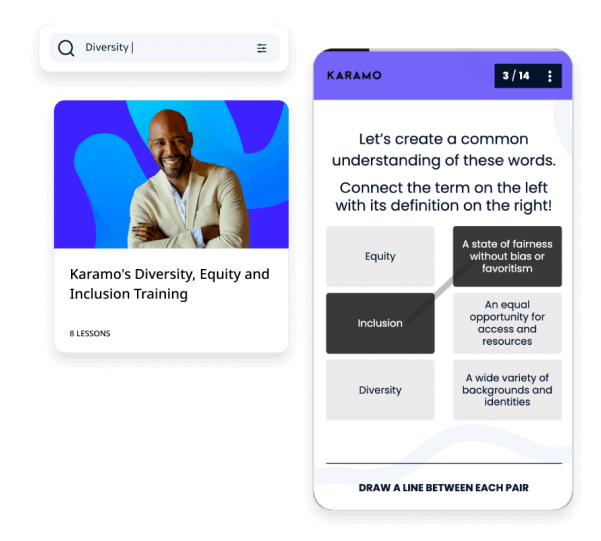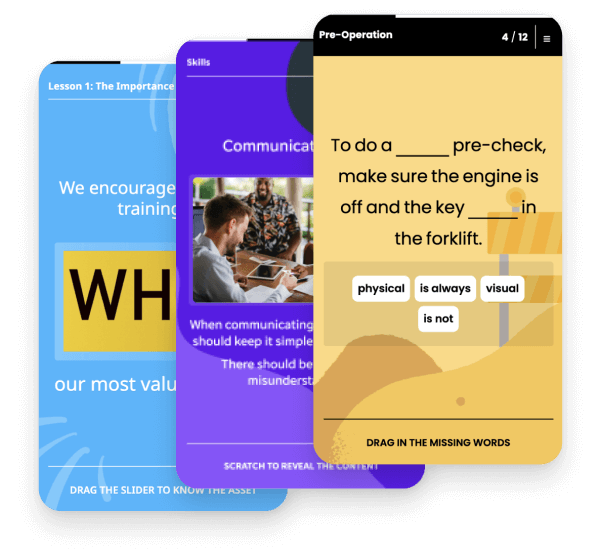10 L&D strategies in the age of automation

Learning and development (L&D) strategies guarantee the adaptability and resilience of individuals and organizations alike. The impact of automation on the workforce means that we need to reevaluate traditional learning approaches and shift towards more innovative strategies.
This article explores the transformative role of artificial intelligence (AI) in L&D that empowers professionals to thrive in evolving workplaces. Here, we’ll walk you through strategies that will allow your team to harness the full potential of automation while addressing the demands of the modern workforce.
What is an L&D strategy?
An L&D strategy is a comprehensive plan devised by organizations to enhance the skills, knowledge, and capabilities of their workforce. It’s a systematic approach to training and education, aiming to align employee development with organizational goals and evolving industry trends.

L&D strategies usually involve the following:
- identification of skill gaps
- designing targeted training programs
- implementing learning technologies
- fostering a culture of continuous learning within the workplace
These strategies are crucial for adapting to technological advancements and industry changes. It guarantees that your employees remain equipped with the skills to contribute to your organization's success.
L&D strategy #1: AI and automation training
Organizations are starting to recognize the need for upskilling and reskilling in the age of automation. This is why they’re incorporating tailored training programs to empower employees with the necessary expertise in AI technologies.

This L&D strategy involves developing technical skills and a deep understanding of the ethical implications and collaborative potentials of AI integration into business processes. By fostering a culture of continuous learning and adaptability, this strategy makes sure that employees can contribute to company innovation and efficiency.
LMS training portals like EdApp are exceptional L&D training tools. On this platform, your team will not only learn about AI, but you can also use AI technology to develop their courses. You can find courses such as Introduction to Artificial Intelligence and Defending Human Rights in the Age of Artificial Intelligence in its course library.

You can also use its AI Create feature to speed up the course creation process. With AI Create, you can overcome writer's block and generate engaging content at the click of a button. This eliminates the need for exhausting brainstorming and research.

Plus, EdApp's user-friendly interface allows for seamless navigation and customization of AI-generated content. This makes course creation efficient, enjoyable, and tailored to the evolving needs of your workforce.
Sign up for EdApp to use the best L&D training tool for your team.
L&D strategy #2: Digital skills training
In response to the rapid digitization of industries, this strategy focuses on enhancing proficiency in a range of digital tools, platforms, and technologies. It includes digital literacy, data analysis, cybersecurity awareness, and proficiency in using collaborative and communication tools.

This learning strategy fosters a workforce that’s not only skilled at using technology but is also prepared for the demands of the continually evolving digital landscape. By prioritizing these skills, your employees can innovate and stay competitive in a digital global economy.
L&D strategy #3: Data literacy training
Data literacy training involves developing a deep understanding of data concepts, interpretation, and utilization so that your employees can effectively analyze and derive insights from data. This L&D training includes data analysis and visualization, as well as an understanding of the ethical implications of data usage.

Implementing this learning and development strategy lets you empower your team to make informed decisions, enhance problem-solving capabilities, and contribute to strategic initiatives. This addresses the increasing importance of data in decision-making and encourages critical thinking and continuous learning.
L&D strategy #4: Cross-training and upskilling
Upskilling focuses on elevating existing skills or acquiring new ones relevant to one’s current or emerging job requirements. On the other hand, cross-training involves exposing employees to various roles and responsibilities within the organization, fostering a broader skill set and adaptability.

Together, these strategies mitigate skill gaps, enhance employee engagement, and promote a resilient workforce. By investing in these initiatives, you can future-proof your teams and create a workforce that can meet the demands of a rapidly changing business environment.
L&D strategy #5: Adaptive learning paths
Adaptive learning paths use data-driven insights to adjust corporate learning and development based on an individual's progress, strengths, and areas for improvement. Adaptive learning platforms have algorithms to personalize content, pace, and assessment methods so that each learner receives a customized experience.

Catering to diverse learning styles improves engagement, retention, and skills mastery. This strategy maximizes the efficiency of training programs and creates a more inclusive and effective learning environment.
L&D strategy #6: Soft skills development
Soft skills development focuses on nurturing the interpersonal, communication, and emotional intelligence competencies that are crucial for professional success. Collaboration and adaptability are needed in the workplace, so it’s essential to invest in soft skills training.

This strategy strengthens your employees' ability to work harmoniously within teams and promotes a workplace culture that values empathy, creativity, and effective interpersonal relationships. It contributes to building a well-rounded and thriving workforce.
L&D strategy #7: Continuous learning culture
Fostering a continuous learning culture embeds a mindset of lifelong learning within an organization. This approach goes beyond specific training initiatives to create an environment where ongoing learning is embraced as a fundamental part of the organizational culture.

It involves promoting self-directed learning, encouraging knowledge sharing, and offering accessible resources for professional development. This strategy also positions the organization to be more resilient in the face of technological advancements and changing market dynamics.
L&D strategy #8: Microlearning
Microlearning revolves around delivering small, focused bursts of content to learners, typically in the form of short modules, videos, or interactive lessons. This approach is designed to cater to the modern learner's preferences for brief and targeted learning experiences that can be easily integrated into busy schedules.

Microlearning emphasizes specific skills or knowledge bites, allowing for quick absorption and immediate application. This L&D strategy accommodates diverse learning styles by offering ongoing, easily consumable opportunities for skill and knowledge enhancement.
L&D strategy #9: Virtual and augmented reality training
Virtual and augmented reality (VR/AR) training uses immersive technologies to simulate real-world scenarios for enhanced learning experiences. VR places learners in an entirely computer-generated environment, while AR overlays digital information onto the physical world.

These technologies allow hands-on training that’s especially beneficial for technical skills or scenarios that may be difficult or expensive to replicate in traditional settings. This type of training improves retention, problem-solving abilities, and skill application.
L&D strategy #10: Employee well-being programs
Employee well-being programs represent a holistic and forward-thinking approach for an L&D strategy. They recognize the integral connection between employee wellness and professional performance.

These programs go beyond traditional skill-building to address physical, mental, and emotional health, for a workplace culture that prioritizes the overall well-being of its employees. Initiatives include stress management workshops, mindfulness training, fitness programs, and mental health resources.
What is the role of AI in L&D?
Integrating AI into your L&D strategies allows you to use the power of data-driven insights, automation, and personalization to create more effective learning experiences for your workforce. Here are some roles that AI plays in L&D:

- Personalized learning paths: AI analyzes individual learner data to tailor training programs based on strengths, weaknesses, and learning styles. This guarantees a personalized and adaptive learning experience.
- Predictive analytics: AI predicts future skills requirements and identifies potential skill gaps within an organization. This proactive approach allows you to implement targeted training programs to meet evolving needs.
- Automation of administrative tasks: AI automates routine administrative tasks such as course scheduling, grading, and progress tracking. This streamlines L&D processes, allowing HR to focus on more strategic aspects of employee development.
- Content curation and recommendation: AI algorithms analyze vast amounts of data to curate relevant learning materials and recommend content tailored to individual preferences and learning objectives. This is for a more engaging and targeted learning experience.
- Gamification: AI is often used with gamification techniques to create interactive and engaging learning experiences. Adaptive learning platforms also use AI to adjust difficulty levels based on individual progress.
Author
Donna Dane
Donna is an elearning content writer for EdApp, a mobile-based microlearning platform designed for today's digital training needs. When she's not writing web articles, she writes lines of code or songs or anything food-related.

